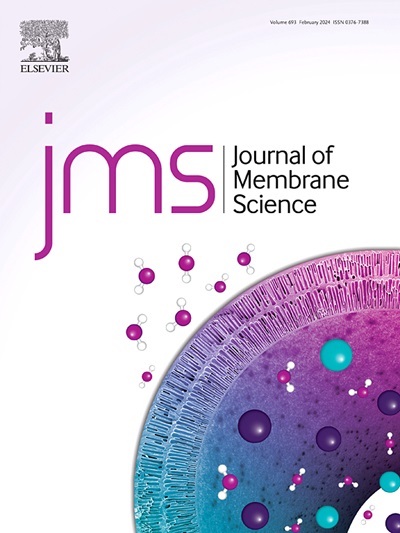CoFeMn层状双氢氧化物纳米限制重力驱动催化膜高效水净化:性能和机制的见解
IF 8.4
1区 工程技术
Q1 ENGINEERING, CHEMICAL
引用次数: 0
摘要
基于过氧单硫酸盐(PMS)的非均相类芬顿催化在污染物去除方面面临着巨大的挑战,因为传质限制和低效的活性氧生成。为了解决这些问题,制备了一种新型的三金属(commn)层状双氢氧化物(LDH)膜,将纳米限制催化与膜过滤相结合。该comfemn LDH膜/PMS系统实现了雷尼替丁的完全降解,一级速率常数为4 ms−1,同时保持了21 LMH的稳定重力驱动渗透通量。值得注意的是,该性能超过了批量规模系统,表现出2.79 × 105倍的速率常数,比最先进的催化膜高出1-4.5个数量级。密度泛函理论计算表明,CoFeMn LDH膜具有较高的PMS吸附能(Eads = - 3.84 eV),表明其具有良好的化学吸附能力,并证实了CoFeMn LDH膜向PMS膜的快速电荷转移机制(1.014 e)。此外,comfemn LDH膜纳米通道内的纳米约束显著增强了药物和内分泌干扰化学物质的降解,并提供了100小时连续运行的稳定性能。本研究证明了三金属ldh基催化膜在可持续和高效水净化方面的潜力。本文章由计算机程序翻译,如有差异,请以英文原文为准。
CoFeMn layered double hydroxide-based nanoconfined gravity-driven catalytic membrane for efficient water decontamination: Performance and mechanistic insight
Heterogeneous Fenton-like catalysis using peroxymonosulfate (PMS) faces significant challenges in pollutant removal due to mass transfer limitation and inefficient reactive oxygen species generation. To address these issues, a novel trimetallic (CoFeMn) layered double hydroxide (LDH) membrane was fabricated, integrating nanoconfined catalysis with membrane filtration. This CoFeMn LDH membrane/PMS system achieved complete ranitidine degradation, with a first order rate constant of 4 ms−1, while maintaining a stable gravity-driven permeate flux of 21 LMH. Notably, this performance surpasses the batch-scale system by exhibiting 2.79 × 105 times higher rate constant and outperforms state-of-the-art catalytic membranes by 1–4.5 orders of magnitude. Density functional theory calculations revealed a high PMS adsorption energy on the CoFeMn LDH membrane (Eads = −3.84 eV), indicating superior chemisorption, and confirmed rapid charge transfer mechanism with electron transfer from CoFeMn LDH to PMS (1.014 e). Furthermore, nanoconfinement within the CoFeMn LDH membrane nanochannels significantly enhanced the degradation of pharmaceuticals and endocrine-disrupting chemicals, providing stable performance for 100 h continuous operation. This study demonstrates the potential of trimetallic LDH-based catalytic membranes for sustainable and efficient water purification.
求助全文
通过发布文献求助,成功后即可免费获取论文全文。
去求助
来源期刊

Journal of Membrane Science
工程技术-高分子科学
CiteScore
17.10
自引率
17.90%
发文量
1031
审稿时长
2.5 months
期刊介绍:
The Journal of Membrane Science is a publication that focuses on membrane systems and is aimed at academic and industrial chemists, chemical engineers, materials scientists, and membranologists. It publishes original research and reviews on various aspects of membrane transport, membrane formation/structure, fouling, module/process design, and processes/applications. The journal primarily focuses on the structure, function, and performance of non-biological membranes but also includes papers that relate to biological membranes. The Journal of Membrane Science publishes Full Text Papers, State-of-the-Art Reviews, Letters to the Editor, and Perspectives.
 求助内容:
求助内容: 应助结果提醒方式:
应助结果提醒方式:


